Morilla 107k, 64m*
The view leaving Toledo on the east was as great as the view entering it on the west. Last (first) shot is the mug – actually a beer cup that was a gift from this restaurant apparently dating back to the 9th century. Had to leave it in the hotel room L. (Note: you can get mini-beers here in Spain for 1 euro.. just right for Bob.)
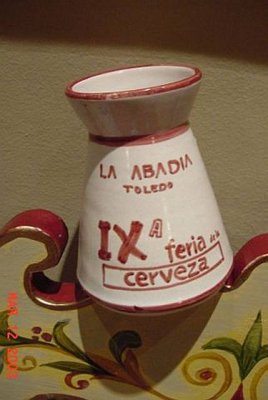
For the first three hours, we headed east and south under good weather and road conditions, and covered a lot of ground. Interruptions included the sheep crossing the road:
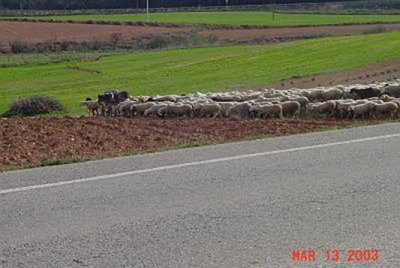
I was a bit late, too close and off center with the photo because I was (astonished) trying to understand how the donkey leading the way, the dogs running alongside, and the man running behind (with the staff/cane/whatever) all worked together to keep the sheep moving along.
Then we had breakfast at 10:30 in LaGuardia (the very small rural Spanish town a hundred kilometers down the NIV autopista, not the airport in NYC), and headed into continuous, strenuous winds for the rest of the day. We left early in hopes of big distance, but it was not possible. Now, in spite of starting a day early, we are (were) 2 days behind schedule. (Damn these sights. Damn these hills. Damn this wind.)
Charlie and I are compensating in three ways: 1) raising our level of perception: When you’re riding across the plains of La Mancha (think Cervantes, think Don Quixote, think historic windmills), you should expect big wind; 2) We took a ride to where we should have ended up today, instead of frying ourselves and not making it, 3) and we have, probably, given up on making Avignon on this leg of the trip. We’ll start the next leg wherever we end up this leg.
OK. All that said, from Toledo to Morilla, there’s not much in the way of scenery. Rolling hills and farms and small villages every 20 km or so – that’s about it. Most of these farm villages are dusty, dirty and with the exception of the churches, without tourist merit. It is interesting to note that, as Charlie pointed out, the people seem to live in the villages and drive their tractors out to the farms, work and return. There is a lot of grape growing here – no trellises just close to the ground root stock like in Santorini.
At 3:00PM we stopped in one of those villages, Quintinar, and hit the supermercado for lunch supplies. The highlight of my day – pate, cherry tomatoes, olives and bread (plus 4 kinds of liquids) for lunch. Charlie did the deli meat/cheese thing. He does proteins, I do carbos. Here’s us sitting on a bench by the church in Quintinar, eating a late lunch.
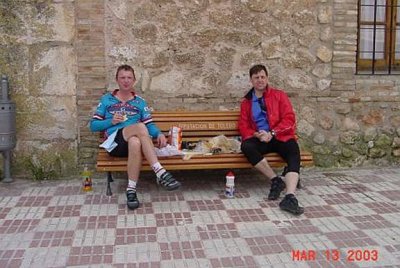
An aside here… as you likely know, Europeans are not keen on “modified” foods, and you can tell when you eat the meat and vegetables. Not as tender, maybe not as big, and they taste different. Hopefully they will be able to maintain their standards (fear) of genetically modified food so we’ll all have a chance to taste beef and tomato’s as they occur naturally.
Moving on, here also is a typical view of the countryside – this one a little closer to town with more stuff than the bigger fields midway between villages.
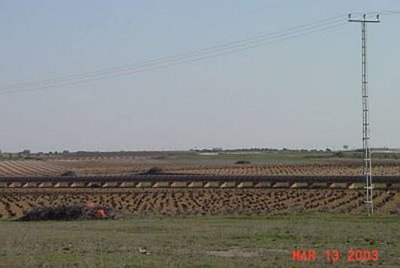
The dark dots on the dirt are wine vines. The horizontal thing is a viaduct – this one a channel supported by concrete blocks. The Romans brought the technology over, and they are still common around here. Finally, one of those famous windmills.
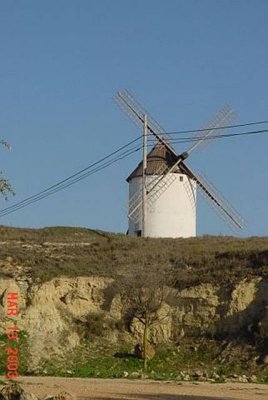
Charlie says the windmills were for wells (water). I thought they were for grain crushing. Anybody really know what they’re for here?
Last thought – if you haven’t read Cervantes yet, consider it. Beautiful stories that he just couldn’t have (but did) written centuries ago. That’s it for this short, sweet update. We press on.

 March 13, 2003
March 13, 2003 